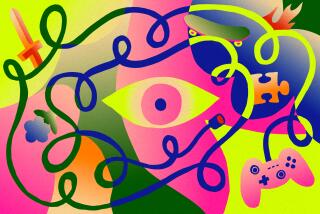Joel McDonald’s puzzle game ‘Prune’ has flowered quickly
- Share via
Not too long ago Joel McDonald was working on video games in which players could pummel bullets into trees. Today, he’s crafted a puzzle game in which players nurture trees.
The result? This former “Call of Duty” designer has one of the hottest games on the market.
His mobile game “Prune” was near the top of Apple’s paid App Store charts for much of last week. Not bad for a game in which the goal is to watch a tree sprout flowers.
With swipes of the hand, players in “Prune” trim or guide a tree around barren, light-starved atmospheres. The more precise the direction, the more flowers the trees will grow. Described as a “love letter” to nature, the $3.99 game brings with it an abstract look and a meditative sound to plant life.
FULL COVERAGE: The Player on games and gaming industry
“Prune’s” instant success also settles a bet McDonald had when he left his job contributing to blockbuster games. He wagered that today’s gamers are hungry for different experiences, perhaps even calming ones. He was right.
“I don’t see the point in making a game that’s already been made,” says McDonald, 31.
“Prune” definitely stands out among its App Store competitors, and not just because it’s absent angry birds in its trees. For one, it’s a puzzle game that looks and feels ambient. The art owes a debt to Japanese ink-wash paintings. As trees grow, they look as if they’re being drawn to life amid bold and simple backgrounds.
Branches can quickly become rather intricate, which is where the game becomes challenging. As trees grow fast, players have to sculpt faster. Trim one branch to let another one live — or change the direction of growth — but trim too much and the tree dies.
There are obstacles. A red sphere, for instance, is dangerous. Don’t let the tree grow into one or it will quickly become brittle and die.
The tone is forlorn. The music, designed by Kyle Preston, is otherworldly. Melancholic electronics sound as if they’re mimicking a string section. It’s patient — a sound for a leisurely stroll through a museum, perhaps.
That’s fitting because “Prune” is a game that feels like an art piece. It all brings a sense of heft to the mission at hand.
Here, glowing dark orbs act as sort of seeds in the sky that provide instant growth spurts. Backgrounds are often formed by little more than gray- or tan-tinted lines and black circles. Combined, they create spotless and unpolluted patterns for which the player must navigate.
Whether intentional or not, there’s a slight underlying sensation of sadness. After all, it’s in the hands of the player to restore life to these seemingly infertile worlds. Each time a flower grows, it does so with a chime, a brief bright burst of noise that pierces the softly bleak score.
“It took me awhile to find the tone and mood of the game,” says McDonald. “I think it was born out of mostly what you were doing. You were controlling a single tree in this landscape. I wanted to play up the feeling of being in this barren, hostile landscape all alone — the single organic life.”
Before creating “Prune,” McDonald had worked seven years at Madison, Wis.-based Raven Software, where he contributed to such franchises as “Call of Duty” and “Wolfenstein.” Inspired by the expansive independent game movement, McDonald grew tired of games in which players shoot things.
“I slowly began to realize I was interested in a different direction than ‘Call of Duty’ or ‘Wolfenstein,’” he says. “I decided to quit my job and my promising career as a designer in the game industry and try to strike it out on my own. I wanted to explore the much larger palette of emotions and experiences that I believe video games can offer.”
Luckily, McDonald notes, going indie was possible because working on “Call of Duty” paid well. He hoped to have his first independent experience finished within a couple of months. “Prune” ultimately took a little over a year as McDonald experimented with numerous early ideas, including a rhythm-based sword-fighting game.
“You’d step to the beat and swipe on your touch pad,” McDonald says. “You’d have to fend off your foe. It was a mix of ‘Guitar Hero’ and a sword-fighting game.”
McDonald was bouncing ideas off his wife, he says, adding that she generally isn’t interested in games. But she liked “Prune,” and that told him he might be onto something. The game was initially inspired by tree-generating computer code created by a friend of McDonald and came into focus as McDonald was strolling around Madison.
“It clicked for me when I saw this half-fallen tree in a field,” he says. “Its branches were sort of splayed out in all directions. What if you can play with and manipulate and shape all the branches? As soon as I had that, I had the prototype up and running in a couple of days.”
McDonald says that since “Prune’s” release in late July it has performed well enough to pay for the year-plus needed to develop it. Part of the game’s success is from luck because Apple placed it on the front of its App Store, but the game’s inherent accessibility certainly didn’t hurt.
One constraint McDonald placed on himself was that the game had to be simple — so simple it didn’t need instructions for a player to navigate it.
“Part of that reason was that so that my 4-year-old could play it,” he says. “Or a 74-year-old could play it.”
The result is a game that makes sense after just a few swipes.
“There’s a huge number of players and people who aren’t traditional gamers who would love to have these experiences,” McDonald theorizes. “They just need to have the right games shown to them.”
MORE FROM THE PLAYER
‘Adr1ft’ helps ‘shamed’ game designer pull his life back together
In the indie game ‘N++’ you get only one life -- and time is ticking
In an era overrun with nostalgia, ‘King’s Quest’ is a thoughtful take on a classic
More to Read
The biggest entertainment stories
Get our big stories about Hollywood, film, television, music, arts, culture and more right in your inbox as soon as they publish.
You may occasionally receive promotional content from the Los Angeles Times.











